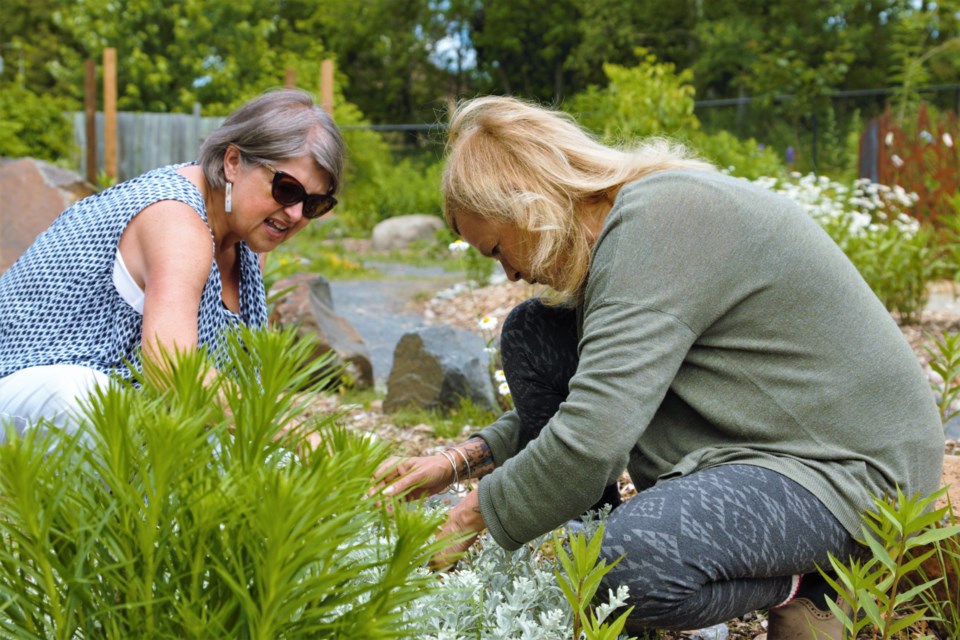THUNDER BAY – With the City of Thunder Bay weeding out rules that restricted the creation of natural habitat on local lawns, those who are already gardening with native plants are hoping more residents will catch the bug.
A recent revamp of Thunder Bay’s yard bylaw supports naturalized yards, exempting alternatives like native grasses and wildflowers from the 20-centimetre height limit for turf grass, among other changes.
It’s a step Toronto-based author Lorraine Johnson, who has written several books on gardening and native plants, says is overdue, pointing to ecological benefits and growing public interest.
She sees replacing monocultures of turf grass with native plants as a way to take action in the face of environmental challenges that can seem overwhelming.
“Actually putting your hand in the earth, nurturing plants, supporting biodiversity – these are climate actions that really do make a difference,” she said. “And you can immediately see that positive impact when you see the birds and butterflies and bees finding a home you’ve helped to create.”
Leola Palmer is one local proponent who got hooked after learning about threats to monarch butterflies from Dan Fulton, who championed the Adelaide Monarch Garden before he passed away last year.
She was inspired to help by planting milkweed (the only plant monarch caterpillars can feed on) and other wildflowers.
"I got drawn into it by the monarch butterfly,” she said. “That was one of Dan’s big pushes… He was doing everything he could to encourage different areas of Thunder Bay to help give a safe haven for the monarch.”
Cynthia Bujold, another volunteer at the Adelaide garden, said Fulton’s concern for monarchs and other besieged pollinators led her to rethink how she cared for her yard.
“When I started gardening, I had the same idea as other people about what a garden looked like,” she said. “Learning about native species and what we need to do to help was the spark – it caught me.”
Johnson said she speaks with many who are aware of those concerns and “poised” to do something, but don’t know where to start.
She encourages newcomers to start small.
“I’ll often suggest people look at what areas of lawn they don’t use right now,” she said. “Start with a small patch and see how it goes.”
“Do it somewhere you’ll be able to see all of the birds and butterflies who visit, because I think that’s what will make you want to expand next year,” she added.
For some, the thought of digging up large patches of grass is intimidating, but most natural gardeners suggest putting down paper, wood chips, or other material to kill the turf with less fuss.
For Debbie DeBruyne, converting her north end yard largely to native plants has brought benefits in the form of reduced mowing, watering, and fertilizing, if not necessarily less work.
“It’s just different work,” she said. “It’s not pushing your lawnmower that takes power – it’s manpower. It’s physical labour just to weed it and spread things around, pot them up and share them with a friend when you have too many of them.”
She plants a variety of species that bloom from the spring to the fall to maximize benefits to pollinators.
Maggie Landry has transformed much of her north end yard since moving in about a year and a half ago, replacing grass and a hedge with patches of native plants.
“I think if people start, they’ll just get hooked, because wildflowers are so beautiful and you can grow so many different varieties in our eco region,” she said.
The process takes some work and a little know-how, she said.
“I think it’s important to reach out to people who are doing it already for help,” she said. “It can be daunting to change your gardening perspective – you’re not gardening for yourself anymore, you’re gardening for the community members in your yard."
Local gardeners swap plants and seeds among themselves, order from local suppliers, or online from outlets like Ontario Native Plants.
They say they have no problem finding varieties that handle Thunder Bay’s shorter growing seasons.
“I think that notion that it’s more challenging in the north comes out of conventional gardening, not native species,” said Johnson. “Habitat gardening with native plants is about working with the conditions at hand. You’re growing plants that will thrive in the north.”
The Lakehead Region Conservation Authority offers a list of native plants suitable to Northwestern Ontario, organized by bloom time, light requirements, and moisture requirements to help you plan a garden well-suited to your backyard.
The agency also suggests native plant suppliers.
Natural gardeners sometimes bump up against what Johnson called “the social pressure – and the legal pressure – for people to maintain a lawn,” but report mostly positive feedback.
“I keep the boulevard mowed, I keep this grass mowed as much as I can, just so it looks cared for,” Landry said. “I don’t think the garden really looks wild – it looks quite beautiful to me.”
“People stop to look a lot at it, and they’re curious. Especially children – last year there were more monarchs, and the kids would stop by and really be enthralled with the butterflies.”
“It definitely piques people’s curiosity,” agreed Bujold. “First of all, when I was killing the grass, it was, ‘What are you doing?’”
“I think about the future generations. If we don’t encourage this, I worry for what’s going to happen in the future. I feel absolutely compelled to do what I can.”
Ultimately, the gardeners say they get as much out of the work as they put in. For Palmer, the work at the Adelaide garden provides a sort of refuge.
“Issues that people have in their life, difficulties – you come down here and you kind of just lose it all for a moment,” she said.



